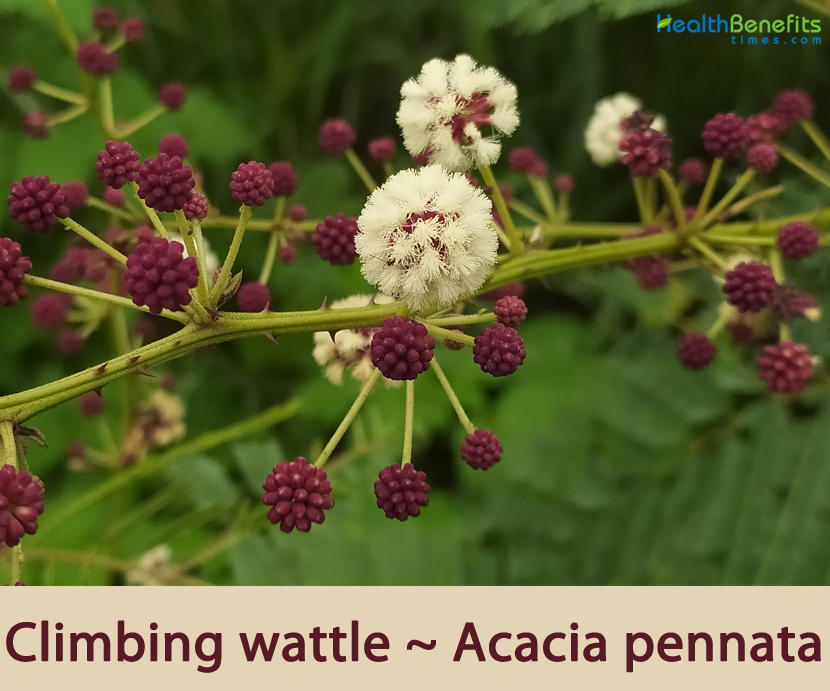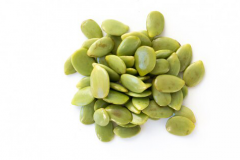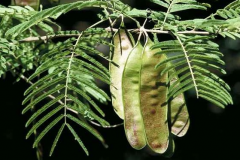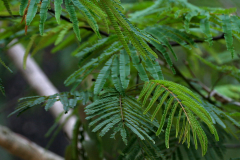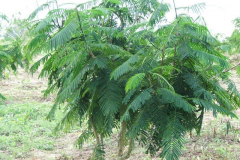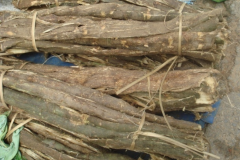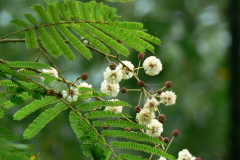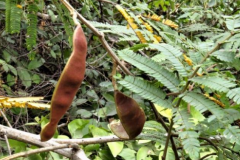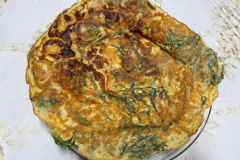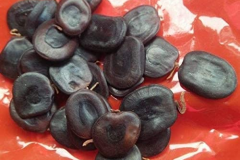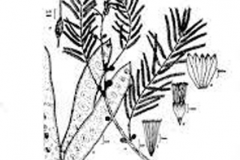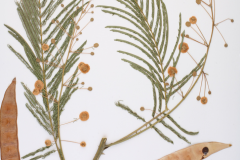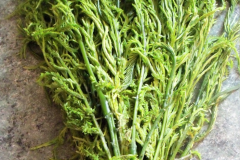| Climbing wattle Quick Facts | |
|---|---|
| Name: | Climbing wattle |
| Scientific Name: | Acacia pennata |
| Origin | South, and South-East Asia, found in Bangladesh, Bhutan, Cambodia, China, India, Laos, Myanmar, Sri Lanka, Thailand, and Vietnam |
| Colors | Initially green turning to brown as they matures |
| Shapes | Straight, flat, thin, strap-shaped, rounded or shortly apiculate legumes or pods that are about 12-15 cm long and 2-3 cm wide |
| Taste | Sweet, bitter |
| Health benefits | Support for stomachaches, migraines, fevers, asthma, bronchial infections, bleeding gums, bile problems, relieve coughs, stimulate appetite, and alleviate female disorders |
| Name | Climbing wattle (Climbing Acacia) |
|---|---|
| Scientific Name | Acacia pennata |
| Native | South, and South-East Asia, found in Bangladesh, Bhutan, Cambodia, China, India, Laos, Myanmar, Sri Lanka, Thailand, and Vietnam; also Indian Ocean- Andaman Islands |
| Common Names | Climbing Acacia, Climbing Wattle, Feather Acacia, Narrow-Leaved Soap Pod, thorny tree, Khang, Stinky Leaf, Petai Duri, Rau Thoi, Cha-om tree, rusty mimosa and wait-a-bit-thorn |
| Name in Other Languages | Assamese: Kuchai Bambara: Toufi-tuku, Tufi Bengali: Kirikitikanta, Kuchui, Nengtaknta, Undaru, Kuchui Chinese: Yu ye jin he huan (羽叶金合欢) Dehra Dun: Agia-Bel, Agla, Alay English: Cha-om tree, Climbing acacia, Climbing wattle, Feather acacia, Narrow-leaved soap pod, rusty mimosa, wait-a-bit-thorn Garhwali: Agalai, Agla German: Cha-om-Baum Gujarati: Khervelya, Kherval Hindi: Agla bel, Aila (यैला), बिस्वाल Biswal, ChilaaTa (चिलाटा), Aila, Latakhadira, Kandiali, Rigad, Shembi, Aazi khair, agali, agla, alay, cheela Irula: Kottuseengai Jhunjhunu: Cheela Kannada: Kaadu seege, Mullu seege, Shembi, Vellai indu, Siguri, Arar, cilatero, kadshige, kadshigi, kadushige, kadusige, kadusuige, katshige, kattu shige, kattusikai, mullusigi, sige, vellai indu Kinyarwanda: Umugeye, Umuyeyo Konkani: Sambu (सांबु) Kumauni: Agla, Awal Lepcha: Baerzhu, Tol-Rik Malayalam: Kaariinja (കാരീഞ്ഞ), Kadacheenikai, Kadchinikai, Kattuchinnika, Mala inja (മല ഈഞ്ച), Kakkinja, Kareencha, Kattusinikka, Peincha, Sunna, chunga, cunna, kattucinikka, pulicha Marathi: Shembarati (शेंबरटी), Shembi (शेंबी), Aarai Velyakhera, Shemb, Shembati, Thembi, araati, romb, shemba vaela, shemberti, shembo Nepali: Arkhu (अर्खु), Arare, Arfu Oriya: Sili, Gohira, Potadontari, Dontari, Nalli-Konti, Pota-Dontari Portuguese: Acácia-espinhosa Sanskrit: Adari, Airavati, Ari (अरि), Ballikhadira, Khadirapatrika, Khadiravallari (खदिरवल्लरी), Shilikhadira (शिलीखदिर), Tamrakantaka (ताम्रकण्टक), Udakirya, Uddala, Vallikhadira (वल्लिखदिर), sandanika, svadikhallari, khadira Santal: Undar Siddha: Indan, Indu, Tender Leaves – Iyak Koluntu Swedish: Klätterakacia Tamil: Inthu (இந்து), Kattintu (காட்டிண்டு ), Kattuchikai (காட்டுசிகை), Kattu indu, Vellai indu, Seengai, Iya Kozhundu, Indam Budai, Inda Mullu, Indu, Kattindu, Mullu-Chingai, Peychiya-Kai, Singlli, Singai-Mullu, cinkai, cinkaimullu, indan, indu, iyak koluntu, iyakkolundu, katcikai, kattikai, kattintu, kattuccikai, kattusikai, mantarcinkai, mulluccinkai, mulluccinkai, mulluciyakkay, peyccirakay, shembi, sherubati, vellai indu Telugu: Giddu korinda, Guba korinda (గూబ కోరింద), Kaarushikaay, Karra Cheeka, Mulukorinda, Korintha, guba korintha, gubakorinda Thai: Cha om (ชะอม), T̂n chaxm (ต้น ชะอม), Dton cha om |
| Plant Growth Habit | Fast-growing, perennial climbing, glabrous shrub or a small thorny stemmed tree |
| Growing Climates | Common along the roadsides, in forests, forest border and cultivated in home gardens |
| Plant Size | Up to 5 meters (16 ft.) in height |
| Branchlet | Young branches are pubescent, green in colour and turn brown with age |
| Leaf | Leaves are bi-pinnately compound. Pinnas are in 8 to 20 pair, and leaflets are more than 30 pair. Petiole is 2 cm long, with a plate shaped gland near the middle or the base. Rachis is grooved, obscurely prickled, with glands opposite to two uppermost pairs of pinnae. |
| Leaf lets | Leaflet blades are 4 to 8 mm long, and 0.5-1 mm broad with leaflet stalks very short, about 0.1-0.2 mm long or absent. |
| Flower | Individual flowers are white or pale-yellow, about 1.2 mm diam. Calyx tube is about 1 mm long, lobes are about 0.9 mm long, hairy only at the apex. Petals are about 2.2 mm long, fimbriate at the apex. Stamens are numerous and filaments about 4 mm long. |
| Fruit Shape & Size | Straight, flat, thin, strap-shaped, rounded or shortly apiculate legumes or pods that are about 12-15 cm long and 2-3 cm wide |
| Fruit Color | Initially green turning to brown as they matures |
| Seed | Seed is flat, elliptic to oblong-elliptic, about 10-11 mm long and 6-7 mm wide |
| Propagation | By Seed or by cutting or grafting |
| Taste | Sweet, bitter |
| Plant Parts Used | Whole Plant, Stem, Heartwood, leaves, bark, root |
Plant Description
Climbing wattle (Climbing Acacia) is a fast-growing, perennial climbing, glabrous shrub or a small thorny stemmed tree that normally grows up to 5 meters (16 ft.) in height. The plant is found growing along the roadsides, in forests, forest border and cultivated in home gardens. Young branches are pubescent, green in color and turn brown with age.
Leaves
Leaves are bi-pinnately compound. Pinnas are in 8 to 20 pair, and leaflets are more than 30 pair. Petiole is 2 cm long, with a plate shaped gland near the middle or the base. Rachis is grooved, obscurely prickled, with glands opposite to two uppermost pairs of pinnae. Leaflet blades are 4 to 8 mm long, and 0.5-1 mm broad with leaflet stalks very short, about 0.1-0.2 mm long or absent. Leaflets are linear to oblong, tip acute, base truncate, glabrous, margin ciliate, veins obscure, midrib slightly prominent, and very close to the distal margin.
One comparatively large saucer-like gland is visible on the upper surface of the compound leaf petiole about 10 mm from its junction with the twig. Stipules are triangular, about 3-4 mm long and caducous. The whole plant is very spiny with numerous recurved spines. Compound leaf rhachis with recurved spines on the underside, leafy twigs and stems armed with recurved spines. Tendrils are spiny, formed from modified branches.
Flowers
Inflorescence is a raceme of pom-pom-like heads. Each head is about 9-10 mm diam. at anthesis. At anthesis flowers emit a strong perfume resembling that of fermenting fruit. Individual flowers are white or pale-yellow, about 1.2 mm diam. Calyx tube is about 1 mm long, lobes are about 0.9 mm long, hairy only at the apex. Petals are about 2.2 mm long, fimbriate at the apex. Stamens are numerous and filaments about 4 mm long. Ovary is hairy and stalked. Style is thicker than the staminal filaments but of similar length. Ovules are about 20.
Fruits
Fertile flowers are followed by straight, flat, thin, strap-shaped, rounded or shortly apiculate legumes or pods that are about 12-15 cm long and 2-3 cm wide. Seeds are 10-12 per pod; each seed is flat, elliptic to oblong-elliptic, about 10-11 mm long and 6-7 mm wide. Funicle is thin. Cotyledons are about 10 mm long and 6 mm wide, each cotyledon lobed at the base. Radicle is about 2.5 mm long.
Traditional uses and benefits of Climbing wattle (Climbing Acacia)
- In Southeastern Asia, Climbing wattle is used medicinally to treat stomachaches, migraines, fevers, digestive troubles and asthma or bronchial infections.
- It is used as an expectorant for coughs and excessive mucus.
- All parts of the plant are used, including the roots.
- Bark is used to treat asthma and bronchitis.
- When mixed with other medicinal ingredients to neutralize snake venom.
- Leaf is ingested to prevent formation of calluses and to control gas, as well as to treat indigestion and bleeding gums.
- Leaf and Root are used to correct irregularities in the blood, treat gas and bile problems, relieve coughs, stimulate appetite, and alleviate female disorders.
- Root is made into a paste, together with the gall bladder of a python, and used to cure tongue sores or roughness.
- It is an ingredient in medicines used to treat urinary disorders and enlargement of the testicles.
- Bark is used for dandruff.
- Stem and heart-wood are used for leprosy, hemorrhages and wounds.
- Whole plant is used for coryza, headache, Leucorrhoea, pain, burns, and digestive disorders.
- Bark of the plant is used to pacify aggravated pitta, and treat asthma.
- Leaves are used in the treatment of fever, disorder of blood, and digestive impairment.
- In India, leaf juice mixed with milk is used for treatment of indigestion in infants.
- It is also used for scalding of urine and for curing bleeding gums.
- Some people use boiled tender leaves for cholera treatment, digestive complaints, relief of headache, body pain and even to cure fish poisoning.
- Root can be used for inducing flatulency and to cure stomach pain.
- Bark is used for treatment of bronchitis, asthma and for stomach complaints.
- Decoction of the leaves is used in the treatment of body pain, fevers and headaches.
- The leaves are chewed with cumin and sugar to treat bleeding gums.
- Poultice made from the fresh seeds is used as applied to burns.
- The juice of the bark is used as an antidote in the treatment of snake poisoning.
- Paste made from the bark is applied topically to treat conditions such as scabies, cuts and wounds.
- They are used in the treatment of diarrhea and dysentery, and can also be helpful in cases of internal bleeding.
- When applied externally, often as a wash, they are used to treat wounds and other skin problems, hemorrhoids, perspiring feet, some eye problems, as a mouth wash etc.
Ayurvedic Health benefits of Climbing wattle (Climbing Acacia)
- Asthma: Fresh stem sap is sucked daily once till cure.
- Bleeding Gums: In Bleeding from the gums the leaves are chewed with Cumin, and sugar
- Body pain, headache, and fever: The decoction of young leaves is taken.
- Digestive disorder of infant: The leaf-juice mixed with milk is given to infants who suffer from indigestion with green stools.
- Diarrhea: Decoction of stem bark is given orally.
- Rheumatism: Extract of root bark is given orally once in a day.
- Whooping cough: 5-6g of stem bark juice is administered daily twice for five days.
Culinary Uses
- The leaves are edible, and used to prepare stir-fries, curry, soups, etc.
- In Thailand, the tender shoots, and leaves of the plant are eaten as salad or cooked vegetable.
- In Burma, Cambodia, Laos, Indonesia and Thailand, the feathery shoots of Climbing wattle are used in soups, curries, omelets and stir-fries.
- Thai people eat raw or fast-boiled leaves but always with ‘samba’, a spicy sauce which is a mixture of garlic, chili, salt, lemon juice, shrimp and shrimp paste.
- Leaves can be used as a vegetable in several hot spicy foods.
- Climbing wattle is utilized similarly to herbs as a flavoring agent and can be incorporated into salads, curries and soups, stir-fries, noodle-based dishes, or mixed into rice.
- In Thailand, the leaves are traditionally cooked in egg-based dishes, similar to omelets, frittatas, or egg casseroles.
Climbing wattle Recipe
Climbing wattle omelet with chili dipping sauce
Ingredients
- 1 cup young Climbing wattle leaves, finely chopped
- 6 eggs
- 2 tsp. fish sauce
- 2 tsp. white sugar
- 125 ml (½ cup) olive, vegetable or canola oil
Chili dipping sauce
- 6 large garlic cloves
- ¼ cup red bird’s-eye chilies
- 4–5 small green chilies
- 2 tbsp. pea eggplant
- 2 tbsp. shrimp paste, or to taste
- 1 large lime, juiced
- 2 tbsp. white sugar
Direction
- To make the chili dipping sauce, pound the garlic and chilies using a mortar and pestle until fine (the finer it is, the hotter it becomes).
- Pound in the pea eggplant, and then add the shrimp paste and pound until finely chopped.
- Add half of the lime juice and the sugar, and pound until smooth but not liquid.
- Add more of the lime juice if necessary.
- Place the Climbing wattle in a bowl.
- Add the eggs and beat until well combined.
- Add the fish sauce and sugar and beat well.
- Heat the oil in a large frying pan over medium heat.
- Pour in the omelet mixture. As it cooks, lift up the edges and allow the uncooked egg to run underneath.
- When nearly set, turn the omelet over to cook briefly, and then slide onto a chopping board.
- Cut into large slices. Serve on a platter with chili dipping sauce on the side.
Other Facts
- In Myanmar the fruits and stems are used for poisoning fish.
- Lac is grown on this species in Madhya Pradesh.
- Bark of the tree is used to tan fishing nets in Mumbai.
- In Thailand people do not put this acacia near the myna cage, otherwise the birds may die.
References:
https://gd.eppo.int/taxon/ACAPE
https://indiabiodiversity.org/species/show/32012
http://www.theplantlist.org/tpl1.1/record/ild-32837
https://en.wikipedia.org/wiki/Senegalia_pennata
http://tropical.theferns.info/viewtropical.php?id=Senegalia+pennata
https://plants.usda.gov/home/plantProfile?symbol=SEPE10


